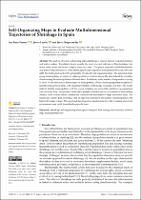Por favor, use este identificador para citar o enlazar este ítem:
https://repositorio.usj.es/handle/123456789/746
Registro completo de metadatos
| Campo DC | Valor | Lengua/Idioma |
|---|---|---|
| dc.contributor.author | Ruiz-Varona, Ana | - |
| dc.contributor.author | Lacasta, Javier | - |
| dc.contributor.author | Nogueras-Iso, Javier | - |
| dc.date.accessioned | 2022-01-26T11:17:18Z | - |
| dc.date.available | 2022-01-26T11:17:18Z | - |
| dc.date.issued | 2022-01-19 | - |
| dc.identifier.citation | Ruiz-Varona, A.; Lacasta, J.; Nogueras-Iso, J. Self-Organizing Maps to Evaluate Multidimensional Trajectories of Shrinkage in Spain. ISPRS Int. J. Geo-Inf. 2022, 11, 77. https://doi.org/10.3390/ijgi11020077 | es_ES |
| dc.identifier.issn | 2220-9964 | es_ES |
| dc.identifier.uri | https://repositorio.usj.es/handle/123456789/746 | - |
| dc.description.abstract | The analysis of factors influencing urban shrinkage is of great interest to spatial planners and policy makers. Population loss is usually the most relevant indicator of this shrinkage, but many other factors interact in complex ways over time. This paper proposes a ultidimensional and spatio-temporal analysis of the shrinkage process in Spanish municipalities between 1991 and 2020. The method is based on the potentiality provided by self-organizing maps. The generated maps group municipalities according to hidden partial correlations among the data behind the variables characterizing the municipalities at different dates. In addition, as the number of map nodes is too big to allow for the detection of distinct types of municipalities, a Ward clustering algorithm is applied to identify homogeneous areas with a higher probability of shrinkage occurring over time. The results indicate that the municipalities with the lowest shrinkage are more stable and have a geographical concentration: they correspond to areas where peripheralization may occur (creation of surrounding districts close to main urban centers) and constitute the hinterland of large functional areas. The results also report a path of decline, with an important increase in the number of municipalities with higher shrinkage values. This approach has important implications for policy making since local governments may profit from shrinkage predictions. | es_ES |
| dc.format.extent | 28 p | es_ES |
| dc.format.mimetype | application/pdf | es_ES |
| dc.language.iso | eng | es_ES |
| dc.publisher | MDPI | es_ES |
| dc.relation | This work is part of the projects T59_20R and S04_20D supported by the Regional Government of Aragon (Spain), and the project PID2020-113353RB-I00 supported by the Spanish Ministry of Science and Innovation (MCIN/AEI/10.13039/501100011033/) | es_ES |
| dc.rights | Atribución 4.0 Internacional | * |
| dc.rights.uri | http://creativecommons.org/licenses/by/4.0/ | * |
| dc.subject | Shrinkage | es_ES |
| dc.subject | Self-organizing maps | es_ES |
| dc.subject | Spatio-temporal data mining | es_ES |
| dc.subject | Non-stationary relationship | es_ES |
| dc.subject | Municipal trajectory | es_ES |
| dc.title | Self-Organizing Maps to Evaluate Multidimensional Trajectories of Shrinkage in Spain | es_ES |
| dc.type | journal article | es_ES |
| dc.identifier.doi | https://doi.org/10.3390/ijgi11020077 | es_ES |
| dc.rights.accessRights | open access | es_ES |
| Aparece en las colecciones: | Artículos de revistas | |
Ficheros en este ítem:
| Fichero | Descripción | Tamaño | Formato | |
|---|---|---|---|---|
| Self-Organizing Maps to Evaluate Multidimensional.pdf | 18,29 MB | Adobe PDF |  Visualizar/Abrir |
Este ítem está sujeto a una licencia Creative Commons Licencia Creative Commons

